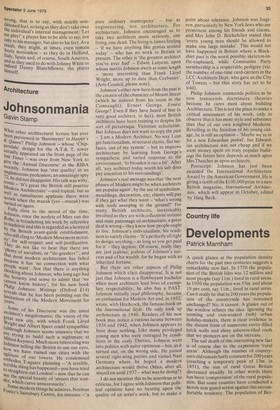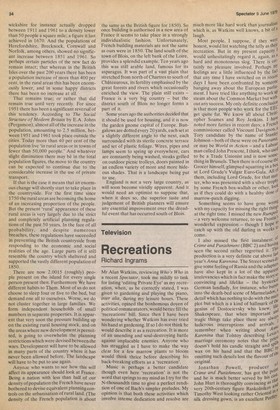Country life
Developments
Patrick Marnham
A quick glance at the population density charts for the past two centuries suggests a remarkable new fact. In 1750 the population of the British Isles was 12 million and most people (say 11m.) lived in rural areas. In 1950 the population was 55m. and about 19 per cent, say 11m., lived in rural areas. Can it really be that in 200 years the population of the countryside has remained unchanged? No, it cannot. A glance out of the window refutes the idea. Ignoring the teeming and rain-soaked (sob) urban holiday-makers, there is clear evidence in the distant form of numerous cavity-filled brick walls and shiny asbestos-tiled roofs that we pioneers are on the increase.
The sad death of this interesting new fact is of course due to the expression 'rural areas'. Although the number of countrymen did remain fairly constant for 200 years (reaching a temporary peak of 13m. in 1851), the size of rural Great Britain decreased steadily. In other words there has been 'compression' of the rural population. But some counties have conducted a heroic rear guard action against this uncomfortable tendency. The population of Ber wickshire for instance actually dropped between 1911 and 1961 to a density lower than 50 people a square mile; a figure it last achieved in 1670. And the populations of Herefordshire, Brecknock, Cornwall and Norfolk, among others, showed no significant increase between 1851 and 1961. So perhaps certain particles of the new fact do remain intact; that whereas in the British Isles over the past 200 years there has been a population increase of more than 400 per cent, in the rural areas this has been enormously lower, and in some happy districts there has been no increase at all.
That remains true; or rather that did remain true until very recently. For since 1951 there has been a significant reversal of this tendency. According to The Social Structure of Modern Britain by E.A. Johns (Pergamon), almost all of the increase in the population, amounting to 2.5 million, between 1951 and 1961 took place outside the cities. Today more than 40 per cent of the population live 'in rural areas or in towns of fewer than 50,000 people.' And whatever slight diminution there may b6 in the total population figures, the move to the country can be expected to continue due to the considerable increase in the use of private transport.
If that is the case it means that an enormous change will shortly start to take place in the countryside. For the first time since 1750 the rural areas are becoming the home of an increasing proportion of the people. But the present `rural' appearance of these rural areas is very largely due to the strict and completely artificial planning regulations of the past 50 years. In the face of all probability, and despite numerous breaches, these regulations have succeeded in preventing the British countryside from responding to the economic and social realities of the age. Large parts of it still resemble the country which sheltered and supported the vastly different population of 1850.
There are now 2.0015 (roughly) people present on the island for every single person present then. Furthermore We have different habits to Them. Most of us do not choose to sleep four or five to the bed, but demand one all to ourselves. Worse, we do not cluster together in large families. We form independent households of small numbers in separate properties. It is apparent that very soon the pressure building up on the existing rural housing stock, and on the areas where new development is permitted, is going to overwhelm the planning restrictions which were devised betweewthe wars. Development will have to be allowed in many parts of the country where it has never been allowed before. The landscape will have to be put to use again.
Anyo.te who wants to see how this will affect its appearance should look at France. Being a nation with less than half of our density of population the French have never bothered to devise equivalent planning controls on the urbanisation of rural land. (The density of the French population is about the same as the British figure for 1850). So once building is authorised in a new area of France it seems to take place in a strongly individualistic fashion. Unfortunately, French building materials are not the same as ours were in 1850. The land south of the town of Blois, on the left bank of the Loire, provides a splendid example. Ten years ago this was still arable land, famous for its asparagus. It was part of a vast plain that stretched from north of Chartres to south of Chateauroux, its fertility emphasised by the great forests and rivers which occasionally enriched the view. The plain still exists — France is a very big country — but the district south of Blois no longer forms a part of it.
Some years ago the authorities decided that it should be used for housing, and it is now the garden gnome capital of Europe. Bungalows are dotted every 20 yards, each set at a slightly different angle to the next, each surrounded with its sterile concrete terrace and set of plastic foliage. Wires, pipes and lamps seem to spring up everywhere, cars are constantly being washed, steaks grilled on outdoor picnic trolleys, doors painted in an endless variety of more and more hideous shades. That is a landscape being put to use.
England is not a very large country, as will soon become vividly apparent. And it would need an optimist to suppose that, when it does so, the superior taste and judgement of British planners will ensure any essential improvement over the dreadful event that has occurred south of Blois.











































 Previous page
Previous page